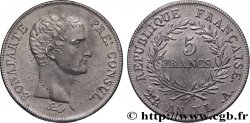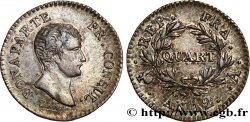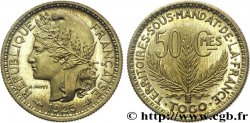v10_0056 - 2 francs Bonaparte Premier Consul 1804 Paris F.250/1
MONNAIES 10 (2000)
Starting price : 838.47 €
Estimate : 1 829.39 €
Realised price : 2 012.33 €
Starting price : 838.47 €
Estimate : 1 829.39 €
Realised price : 2 012.33 €
Type : 2 francs Bonaparte Premier Consul
Date: An 12 (1803-1804)
Mint name / Town : Paris
Quantity minted : 187121
Metal : silver
Millesimal fineness : 900 ‰
Diameter : 27 mm
Orientation dies : 6 h.
Weight : 10,02 g.
Edge : inscrite en creux * DIEU PROTEGE LA FRANCE
Rarity : R2
Coments on the condition:
Frappe parfaite et absolument passionnante car elle présente aussi, comme les 1/2 franc et 1 franc une légère rayure sur la pointe du cou. Un examen à la binoculaire x40 prouve indubitablement que cette encoche est d'origine et se trouvait dans le coin car elle a, sur toute sa surface intérieure, la même surface d'origine que le reste de la monnaie. L'hypothèse de la marque "d'authentification" par fausse rayure sur la pointe du cou est encore une fois confirmée par cet exemplaire. La fausse rayure devrait se retrouver sur d'autres exemplaires du même coin. Nous ne disposons évidemment pas d'un autre exemplaire du même coin mais le An 13 Paris de la Collection Kolsky (N° 2518), en suffisamment bon état pour être probant, montre aussi la trace d'une "rayure" verticale sur la pointe du cou. Malheureusement, à l'époque de la rédaction de ce catalogue, la théorie n'ayant pas encore été formulée, aucun examen particulier ne fut consacré à cette rayure, alors considérée comme un défaut accidentel et non comme une marque volontaire dans le coin.
Le coin de droit est presque à fleur, avec un reflet métallique sans velours sur la pièce ; le coin de revers, moins neuf mais pas encore repoli - aucune trace de cet ordre sur les champs - a donné beaucoup plus de velours. L'effet de contraste du droit est fondé sur l'effet "bas-relief", la différence de réflexion de la lumière sur les courbes des reliefs et le plat du flan en lumière réfléchie directement. Impact visuel d'autant plus étonnant que l'on ne voit jamais cette monnaie dans un état pareil. Au revers, le léger velours remplit son office pour rendre les reliefs légèrement mats tout en laissant le flan largement réfléchissant. Très légère patine grise métallique au droit, avec un soupçon de nuance jaune dans les lettres, plus consistante au revers surtout dans les lettres de la légende. À l'avers comme au revers les lettres ont un effet "de trainée" qui laisse un petit rectangle blanc sans patine entre l'extérieur de la légende et le listel. Nous n'avons pas d'explication pour la genèse de cet effet ; certains parlent de gaz qui s'échappent depuis le centre pendant la frappe et laissent la zone derrière les lettres intouchée, mais cette théorie n'a jamais été prouvée. La tranche est parfaitement nette, régulière, centrée et profonde, sans pourtant que les listels n'en aient été affectés.
Rien à signaler à l'œil nu, la monnaie est parfaite - la loupe x10 permet de voir une faiblesse de surface d'origine sur les cheveux à la lisière du front, deux minuscules chocs - probablement d'origine - sous le menton
Catalogue references :
Obverse
Obverse legend : BONAPARTE - PREMIER CONSUL..
Obverse description : Tête nue de Bonaparte à droite ; signé Tiolier cursif au-dessous.
Reverse
Reverse legend : RÉPUBLIQUE FRANÇAISE./ 2/ FRANCS. AN 12. .A..
Reverse description : au centre dans une couronne formée de deux branches d'olivier.
Commentary
Cet exemplaire est celui de la Collection Idéale. Il illustre le type dans le FRANC III en couleurs. Cet exemplaire est bien évidemment le plus beau jamais répertorié dans la Collection Idéale.
This example is from the Ideal Collection. It illustrates the type in FRANC III in color. This example is obviously the most beautiful ever listed in the Ideal Collection.
This example is from the Ideal Collection. It illustrates the type in FRANC III in color. This example is obviously the most beautiful ever listed in the Ideal Collection.








 Report a mistake
Report a mistake Print the page
Print the page Share my selection
Share my selection Ask a question
Ask a question Consign / sell
Consign / sell
 Full data
Full data













